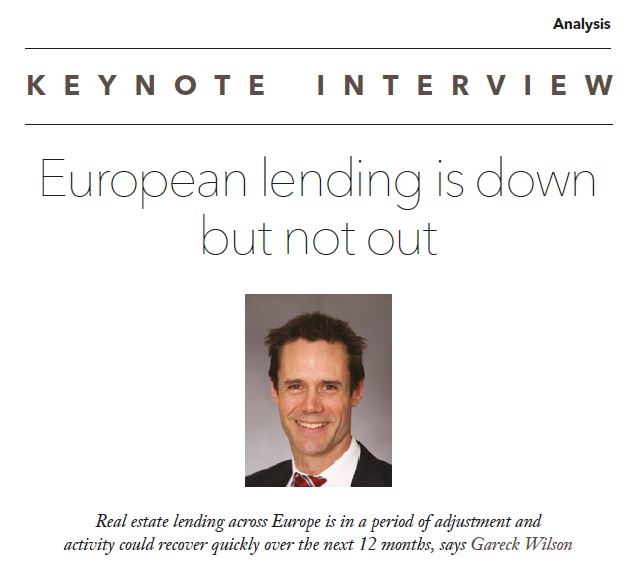Real estate lending across Europe is in a period of adjustment and activity could recover quickly over the next 12 months, says Gareck Wilson

Rising interest rates and inflation have sent European real estate reeling and lenders are seeing more distress in their investment portfolios.
However, while certain sectors and markets may be facing pockets of genuine turmoil, there is no widespread distress as occurred during the global financial crisis. The challenge is for lenders and sponsors to adjust to the new normal in real estate equity and debt markets, says Gareck Wilson, managing director at loan servicing and advisory company Solutus.
Q
What degree of distress are you seeing in real estate lending across Europe, and which factors are impacting lending activity for banks and debt funds?
Based on what we see in the portfolios we manage and the discussions we’ve had with various lenders and sponsors, we are not seeing wholesale levels of distress at the moment. We are certainly seeing high levels of stress following the decline in European real estate values, higher LTV ratios and higher interest rates causing lower cash coverage and covenant breaches or the need to refinance.
We’re certainly seeing levels of stress across the market, and some of that is more distinct on specific assets or in specific jurisdictions. However, if you think about the sort of deep distress we saw during the GFC, while there are certainly pockets of that, we really haven’t seen widespread distress or sales of non-performing loan portfolios.
Q
What changing demands do loan servicing and advisory businesses face in this environment, and what do clients require?
Taking Solutus as an example, it was formed in 2010 to focus on legacy commercial mortgage-backed securities transactions as special servicer or for creative workout plans, but our focus changed in 2015-16 to primary servicing and loan management. But now the market has changed again; lenders are looking for added value, not just administrative services. They want you to be proactive, to get ahead of the curve and see what is going to happen, whether it is with covenants or cashflows, or if there will be a need to refinance and to be able to provide some sort of meaningful commentary or analysis around that.
We are getting more requests from lenders to be more involved, particularly when things aren’t going as they should be. Alternative lenders tend to be very experienced in terms of their underwriting and their management, but some of the more traditional lenders don’t necessarily have that expertise, nor do insurance companies or other funds who have taken a piece of a syndicated loan.
So now we are rebuilding that special servicing capability, although we are moving away from that CMBS terminology. The demand is for advice on workouts, loan restructuring – whether it be for the borrower or the lender – and debt funding gap analysis.
Q
How does this downturn differ from the GFC?
The GFC, to my mind, was a real crash with numerous causes: systemic banking failure, banks being highly leveraged, toxic assets and a liquidity crunch. This time it is not as broad based and systemic. The issues that are occurring are effectively due to governments pulling levers to control inflation. So we have seen some small US banks fail and the rescue of Credit Suisse, but there’s no Lehmans, no Bear Stearns. This is certainly a downturn, but not a crash.
Values are coming off, but values were starting to look frothy. You may go from 60 percent LTV to 70 percent, and that is not a comfortable position, but you are not going from 70 to 150. Credit underwriting standards are a lot more stringent than they were prior to the GFC, too.
Q
Are there specific geographies demanding more attention?
The one geography that is requiring more attention is Germany. That is probably a key focus in terms of our portfolio now, where there is a red flag in a jurisdiction which is going to require attention. It is a market which has gone through a long period of zero-percent interest rates, like a lot of other jurisdictions, but it also has a very competitive domestic lending market. Sponsors could get very competitive financing from the German banks for development and also for opportunistic strategies, where leverage may have been considerably higher than senior debt.
Now there is some pressure on these loans, particularly on those development sites where financing costs are going up and which have also suffered from rapid inflation in construction costs. There are construction projects which are stalling. There are projects where sponsors need to put in a significant amount of new equity in order to keep things going, which some are less inclined to do.
Meanwhile, some lenders are being asked to provide significant uplifts in loan commitments due to widening of construction costs and finance costs. Lenders, however, may be wary of doubling down on those sorts of pro- jects and are worried about the risk of throwing good money after bad.
Such problems aren’t necessarily widespread, and I don’t think the levels of stress in income-producing assets are necessarily different from, say, the UK, but there are some highly leveraged development facilities in Germany because of the competitive nature of the funding market, so we are seeing more stress and distress there.
Q
Which sectors are more affected, and which are more resilient?
The sectors where you are more likely to see stress are those where the long-term fundamentals are still a bit uncertain. For example, office and retail assets which aren’t prime or super prime are probably requiring more attention. Meanwhile, sectors like student accommodation, logistics, industrial and multifamily, which have strong long-term fundamentals, are a lot more certain and a lot more positive.
And development is also more likely to be stressed in any market, even if the previous funding environment was not as aggressive as in Germany. Higher construction costs and finance costs are universal. If you are a traditional lender in a development that starts going pear shaped, you can be in a real spot. You don’t want to enforce and then get lumbered with a half-finished building.
Q
What are lenders’ preferred geographies and sectors?
Everyone acknowledges that the retrenchment of the banks means an opportunity for alternative lenders which have capital raised or have a track record of raising capital. However, I am not sure many of them are chasing specific sectors or specific jurisdictions, because diversification is obviously key in this sort of market.
If you go chasing particular jurisdictions, particular asset classes, you might start chasing deals, rather than having a bit more of an agnostic approach and looking at deals on a case-by-case basis. That said, the whole loan is a pretty compelling argument at the moment, just given the accretion to equity return.
The debt funding gap piece is also an opportunity, but it is not as straightforward as just throwing more debt into the capital stack. If your mezzanine debt can’t be serviced, it’s accruing and then potentially getting underwater. Then you are back to where you started from in terms of a problem for the sponsor. However, there are alternative lenders out there that have the expertise to provide a more structured solution.
Q
What are you seeing with regard to non-performing loans?
There are certainly loans which are non-performing now, and potentially, where lenders will take impairments, but not at the level we saw in 2008-10. What we haven’t seen yet is large, non-performing loan portfolios coming to the market or being traded off-market. We’ve seen individual cases where people might be interested in selling the loan as a solution rather than trying to work it out, but we haven’t seen NPL portfolios, as such.
I think the larger, more traditional banks that deal with good-quality, institutional sponsors and higher quality assets are okay, but they probably hold positions they would prefer not to, due to the leverage and the capital associated with holding those positions. Perhaps some of the smaller banks or lenders in the bridge loan space may see some non-performing loans, not because of their underwriting, but as a consequence of lower quality sponsors and assets, or just smaller assets. So there will be more to come as people adjust to the new normal, but that will take a good 12-24 months as we see more transaction activity and more stable values. It is hard to take definitive action when you are not sure where the market will end up.
Q
What is the outlook for the next 12-24 months?
We were a bit surprised about how quiet the first six months of this year were. I think perhaps some of the alternative lenders are still raising capital and deciding strategy, but we expect to see a lot more of them coming into the market in Europe, as they have in the UK. We may also see some big-ticket lending from insurance companies.
However, we will start to see a lot more lenders entering the market and transactional volume will start to increase in the next 12 months and we will get towards that new normal. Banks will be under pressure to deal with those loans where the cost of capital is proving to be onerous, and they will want a solution. It may not necessarily mean enforcing, but borrowers will be forced to bring in mezzanine or refinance. So that means a lot more activity in the next 12 months.
I am pretty optimistic about the market. I think there is a significant opportunity for lenders now, particularly the alternative lender. There will be rebalancing and adjustment then things will pick up again, and I would be pretty bullish about 2024.
As published in Real Estate Capital Europe • Autumn 2023






